新标准英语第八册M10教案
《英语》(新标准)(初中)初二上册M10第一课时教学设计1

And it’s cloudytoo, so it might snow.
It’s probably sunny and hot there.
Take your swimming clothes because you might want to go swimming in the sea, even in December.
InAlaskathe days are long and warm in summer, but may be cool in the evening.
功能:能够描述天气情况。
技能目标:①能够对照天气示意图,听懂天气预报;
②能够使用英语谈论、描述天气;
③能够读懂描述天气情况的语言材料。
④能够就游览某地给出建议,并使用because, so, but等说明原因和结论。
本模块的任务要求学生就到中国旅游的最佳时间提出建议,给朋友回复邮件。教师要给出必要的背景知识,引导学生全方位思考,以便提供实用、有效的建议。教师要鼓励学生结合自己的经历和经验回复邮件,并尽量运用本模块所学的表示可能性的单词和句型以及描述天气的表达方式,同时注意语言要得体、简练。
2.学生情况分析
八年级是初中的过渡年级,学生的英语基础薄弱,但对学习充满热情和积极性乐于表达自己的思想。本校的大部分学生是外来务工子弟,“天气”与我们的生活息息相关,他们有很多话要说。学生好奇心强,喜欢探究、合作、讨论以及多样的教学模式,本课设计多个游戏操作环节,增强学生的兴趣和注意力,并采取分组教学,组内合作,组间竞争,让学生自如表达自己的思想,和同学交流有关家乡的话题。根据初中生的特点和认知规律,教师制定教学目标如下:
听说课是由贝蒂和玲玲要去滑冰引出了谈论天气的对话,借助这样一个常见的场景轻松地导入了谈论天气的习惯表达和表示可能性的词汇和句型。掌握好有关天气的习惯表达方式,有助于学生更好地与他人交流,增进感情。
新标准英语三年级起点第八册全册教案

新标准英语三年级起点第八册全册教案教学内容本教案是针对新标准英语三年级起点第八册的全册教学内容进行整理和安排。
该教材主要包含以下几个单元:1.Unit 1: My House2.Unit 2: My School3.Unit 3: My Family4.Unit 4: My Hobbies5.Unit 5: My Daily Life6.Unit 6: Festivals7.Unit 7: Animals8.Unit 8: Nature每个单元都有相应的主题和教学目标。
在教学过程中,我们将通过多种教学活动来帮助学生掌握相关的词汇、语法和表达能力。
教学目标本教案的教学目标主要包括以下几个方面:1.让学生掌握本教材中的词汇和常用表达方式。
2.培养学生的听、说、读、写的综合语言运用能力。
3.通过多样化的教学活动,激发学生的学习兴趣和积极性。
4.培养学生的合作意识和团队合作能力。
教学准备在教学过程中,教师需要做好以下准备:1.熟悉教材内容和教学目标。
2.准备教学课件和教学素材。
3.安排教学活动和教学任务。
4.准备评价和反馈的方式和工具。
教学步骤第一课时:Unit 1 - My House1.课堂导入:教师通过展示房屋的图片来引导学生讨论房屋的基本结构和功能。
2.新词学习:教师向学生介绍和教授与房屋相关的词汇,如house、bedroom、kitchen等。
3.语言表达:教师模范表达关于房屋的基本句型,并让学生模仿和练习。
4.听力训练:教师播放与房屋相关的听力材料,让学生进行听力理解和回答问题。
5.对话练习:学生分组进行对话练习,描述自己的房屋和房间。
6.小结:教师对本节课的重点内容进行总结,并布置家庭作业。
第二课时:Unit 2 - My School1.课堂导入:教师通过让学生回顾自己的学校生活,引导学生讨论学校的一些基本设施和活动。
2.新词学习:教师向学生介绍和教授与学校相关的词汇,如classroom、library、playground等。
外研社新标准英语第八册第一模块第一单元教案
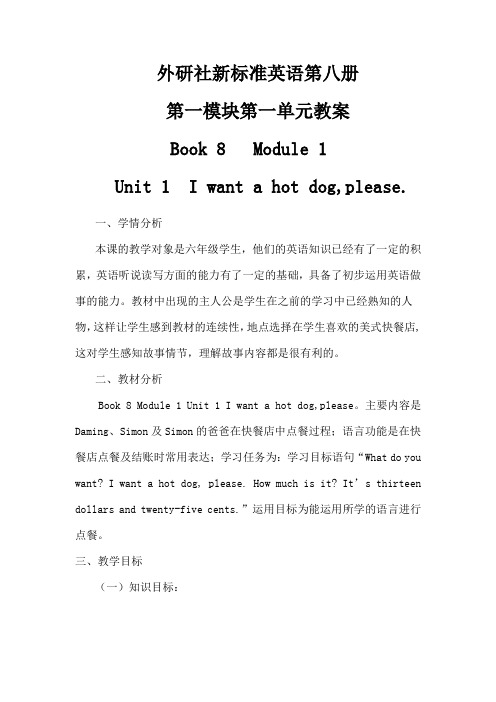
外研社新标准英语第八册第一模块第一单元教案Book 8 Module 1Unit 1 I want a hot dog,please.一、学情分析本课的教学对象是六年级学生,他们的英语知识已经有了一定的积累,英语听说读写方面的能力有了一定的基础,具备了初步运用英语做事的能力。
教材中出现的主人公是学生在之前的学习中已经熟知的人物,这样让学生感到教材的连续性,地点选择在学生喜欢的美式快餐店,这对学生感知故事情节,理解故事内容都是很有利的。
二、教材分析Book 8 Module 1 Unit 1 I want a hot dog,please。
主要内容是Daming、Simon及Simon的爸爸在快餐店中点餐过程;语言功能是在快餐店点餐及结账时常用表达;学习任务为:学习目标语句“What do you want? I want a hot dog, please. How much is it? It’s thirteen dollars and twenty-five cents.”运用目标为能运用所学的语言进行点餐。
三、教学目标(一)知识目标:1. 听懂会说单词hamburger cola hot dog dollar cent enjoy。
2. 能够听懂、会说目标语句: What do you want? I want a hot dog, please. How much is it? It’s thirteen dollars and twenty-five cents.并能运用以上语句进行点餐应用。
(二)技能目标:1. 学生能够在创设的情景中熟练表达自己喜好的食物,并进行点餐。
2.能够熟练与售货员进行交流,并运用所学语言进行购物。
(三)情感目标:体验感受和理解西方国家的饮食习惯,了解一些西方食物的来由及历史。
四、教学重难点重点:学会句型What do you want? I want…,please;How much is it? It’s…难点:新句型的综合运用五、教学过程Step 1: Warm-up and preview1.Revise Spoken EnglishT:Good morning ,boys and girls.How are you ?Ss: I’m fine ,thank you.T:It’s nice to see you.Ss:It’s nice to see you ,too.T:Did you have an enjoyable holiday?Ss:Yes.T:What did you do on the holidays?……Step 2:Presentation and practice1. New wordsT:My favourite food is noodles. My favourite drink is cola.(出示可乐的图片,学习单词cola。
新标准英语第八册教案
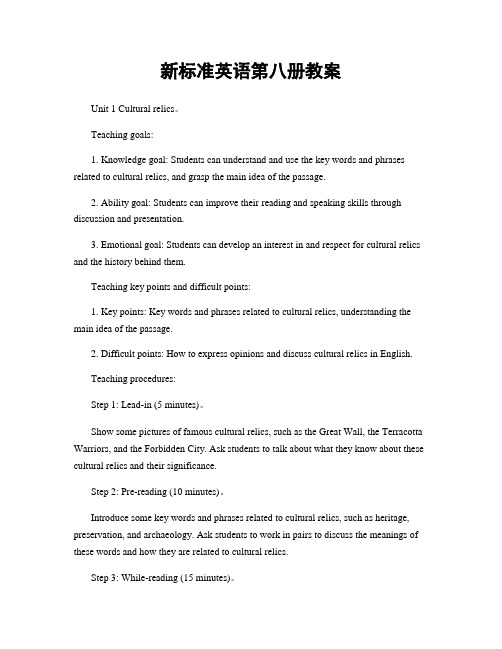
新标准英语第八册教案Unit 1 Cultural relics。
Teaching goals:1. Knowledge goal: Students can understand and use the key words and phrases related to cultural relics, and grasp the main idea of the passage.2. Ability goal: Students can improve their reading and speaking skills through discussion and presentation.3. Emotional goal: Students can develop an interest in and respect for cultural relics and the history behind them.Teaching key points and difficult points:1. Key points: Key words and phrases related to cultural relics, understanding the main idea of the passage.2. Difficult points: How to express opinions and discuss cultural relics in English.Teaching procedures:Step 1: Lead-in (5 minutes)。
Show some pictures of famous cultural relics, such as the Great Wall, the Terracotta Warriors, and the Forbidden City. Ask students to talk about what they know about these cultural relics and their significance.Step 2: Pre-reading (10 minutes)。
外研社新标准英语NSE Book 8第八册教案备课

.Further Development
1、Give them 2 minutes to practise the text in groups.
2、Check the students.
3、Ask them look at Exercise 3,then
work with a partner.
to read the sentences and the other person point to the picture.
4、The students say the sentences as quickly as possible.
5、Finish the Activity book on page 3,exercise 3.
4、Check the students.
5、Have a test.
.Homework
1、Encourage the students to practice the drills after class.
2、Copy the new words 4 times.
3、Read the text 2 times.
2、Try to undeBiblioteka stand the meaning .
3、Listen and draw.
4、Answer the questions.
5、The students listen and repeat.
6、The students say the key words and sentences in different ways.
Students’ Activity
1、Answer the questions.
《英语》(新标准)(初中)八年级上册M10第三课时教学设计1
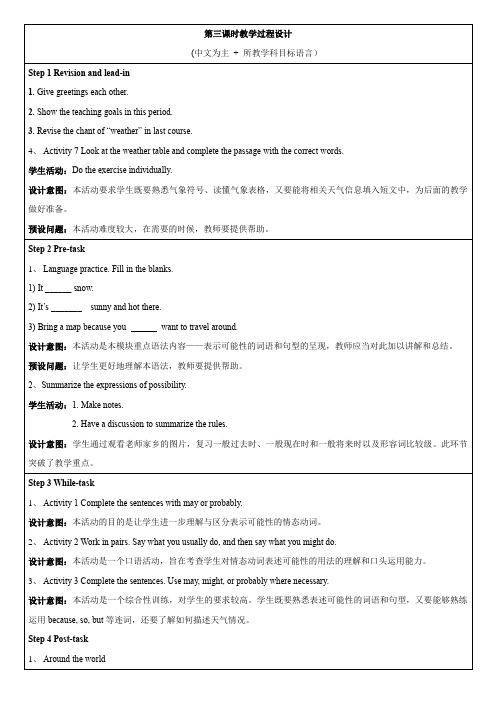
方法 内容评价情况 自 他 组 师 评 评 评 评 课前准备课堂表现任务学习话题表演书法练习听录音说、读英语看英语节目完成作业及时预习复习进步与否板书设计整体模块教学反思:本校生源大部分是外来务工子弟,他们的英语听说能力相对较弱,授课采用较深的全英教学,同学们还不能适应。
另一方面,同学虽然比较活跃,上课气氛积极,有话可说,但个体与个体差别比较大。
因此,讲得太深,没有照顾到整Module 10 The weather Unit 3 Language in use1. It might snow.2. It’s probably sunny and hot there.3. Bring a map because you may want to travel around..体。
由此可以看出,了解及分析学生实际情况,实事求是,具体问题具体分析,做到因材施教,对授课效果有直接影响。
本模块整个围绕“天气”而展开,巧妙利用活动学习英语的同时,对学生进行情感教育我们要培养对地理知识的兴趣。
英语听说课的教学旨在提高学生的听力理解能力和口语交际水平,力求促进学生英语素质的全面发展。
听说教学是英语学习的先决条件,听说水平的高低在一定程度上反映了一个学生的英语整体水平。
首先,听说课设计的活动形式要多样、互动性强,调动学生参与活动的积极性,激发学生的认知兴趣和探究欲望。
听说课设计的活动要以学生的生活经验和兴趣为出发点,创设贴近学生生活的情境,使活动具有可操作性。
其次,教师的课上训练形式要侧重于学生的交际能力培养。
笔头练习活动要与口头活动结合起来。
应充分设计不同层次活动,设计不同层次的问题,以此来迎合不同层次学生的要求,让不同层次的学生都能开口。
最后,听说课的时间分配设计要合理。
一节课的时间极其宝贵、有限。
教学设计中每个环节的时间安排与使用效率是值得教师重视的。
我们教师应当从读写整合课的教学目标出发采纳以读带写,以写促读,读写并进的阅读教学法。
新标准英语八册第10模块
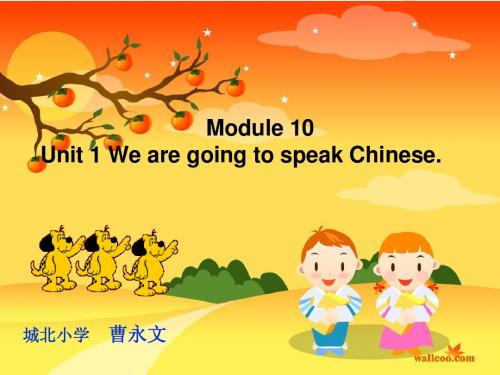
城北小学
曹永文
Step 1 Let’s show
1、Let’s sing a song “Why Why Why” 2、Now who would like to show the new words and phrases? 3、Find out the knowledge what you want to know
3 、 难点解疑
be going to句式的用法
1、Are you going to go to middle school
tonight thisnext year, September
?
◆如果时间状语变换为 … be going to结构仍 不变。 2、 Read sentences and choose “am going to, is going to , are going to”.
SamIand Amy Daming you we she He
… go to middle school this September.
◆be动词在不同人称下会有形式的变换。
Step 4: Consolidation(巩固达标拓展) Look ,read,write
1) Now he is playing football. He is going to swim soon . He Now I am reading a book. I
Homework
1、必做题 询问同学要去哪所学校读书, 简单询问理由。把它记录下来 2、选做题 以文字的形式把自己暑假要做 的事情写出来 。
小组合作
1、找出六个带有“be going to”句子 2、找出下列问题的最佳答案 (1)What subjet is Daming Daming going to study ? He is going to study Physics, Chemistry History. (2)Where are Sam and Amy going to go? They are going to go England. (3)What are Sam and Amy going to do there? They’re going to speak Chinese. (4)who will Sam and Amy miss? They will miss Daming.
新标准英语三年级起点第八册全册教案
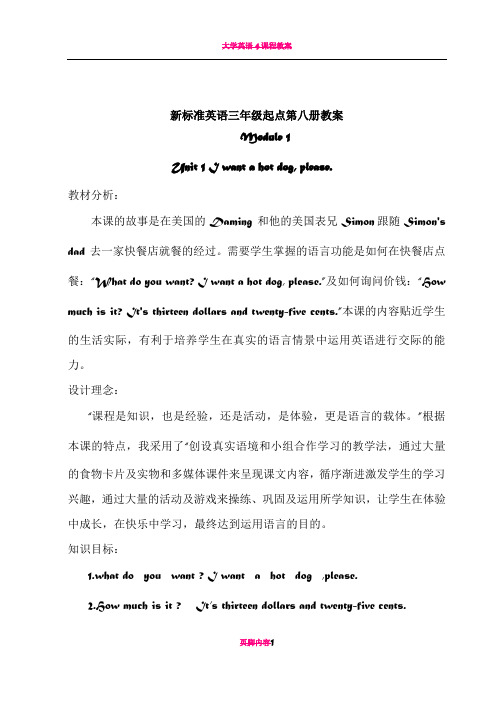
新标准英语三年级起点第八册教案Module 1Unit 1 I want a hot dog, please.教材分析:本课的故事是在美国的Daming 和他的美国表兄Simon跟随Simon's dad 去一家快餐店就餐的经过。
需要学生掌握的语言功能是如何在快餐店点餐:“What do you want? I want a hot dog, please.”及如何询问价钱:“How much is it? It's thirteen dollars and twenty-five cents.”本课的内容贴近学生的生活实际,有利于培养学生在真实的语言情景中运用英语进行交际的能力。
设计理念:“课程是知识,也是经验,还是活动,是体验,更是语言的载体。
”根据本课的特点,我采用了“创设真实语境和小组合作学习的教学法,通过大量的食物卡片及实物和多媒体课件来呈现课文内容,循序渐进激发学生的学习兴趣,通过大量的活动及游戏来操练、巩固及运用所学知识,让学生在体验中成长,在快乐中学习,最终达到运用语言的目的。
知识目标:1.what do you want ? I want a hot dog ,please.2.How much is it ? It’s thirteen dollars and twenty-five cents.能力目标:能用英语来表达如何点餐及询问价钱。
情感目标:激发学生的学习热情,了解中西方的饮食文化异同,并进行文明礼仪教育。
教学重难点:中西方在价格表达上的异同(1美元=100美分)教学用具:Tape recorder, CAI, some food教学准备:课前调查班级中去过西餐快餐店的同学有哪些,他们都了解哪些快餐。
教学过程:Warm up1.Greetings2.Free talk3.Game: Do as I say, not as I do.Presentation1.Show some pictures of food to the students.2.Stick them on the board after read.3.Then the teacher touches the stomach and says: “I’m hungry and thirstyand thirsty, now. I want some noodles cake /cola/hamburger…”and writethe new words on the board.4.TalkT: I want a hot dog .Are you hungry? What do you want?S: I’m hungry, too. I want …5.Then do this activity in pairs.New Teaching1. (Talk) T: Now, we are all hungry .Let’s go to a fast food restaurant. Ss: That’s great!2. Now, look at the screen and look at these questions, then answer. (播放CAI,生动直观呈现课文内容,理解后回答以下问题,培养学生分析问题,解决问题的能力,同时渗透学法)a. Where are Daming, Simon and Simo n’s dad?b. Is a hot dog really a dog?c. What does Simon want to eat?e. What does Simon’s dad want to eat?f. How much is the meal?3. Study in their groups.4.Find out new words and sentences, and then write them on the board.5.Explain “dollar and cent”. “1 dollar is 100 cents.”6.Practise them with your partner.7.Answer those questions.Practice1. Now let’s make a fast food restaurant .Y ou can buy something that you want. (Ss put their food on the teacher’s desk.)2. Do the activity in their groups.3. Then choose one group come to the front.Game1.Guessing game.2.Choose and order.HWCollect more western food.Designs:What do you want?I want a hot dog/ hamburger/ cola /, please.How much is it?It’s thirteen dollars an d twenty –five cents.新标准英语三年级起点第八册教案Module 1Unit 2: What do you want to do?Warm up1.Greetings2.Free talkNew Teaching:Activity 1: Look at the menu. Then ask your food and pay for yourfood.1.Show a restaurant menu to the students.2.Have them look at the menu and talk with their partners.3.Do the activity in their groups.4.Have one group come to the front.Activity 2: Match (Race)Y ou’ll be the winner of this week if you get the flag.(谁在单位时间内点出的食物样数多并准确算出应付的钱数,就获得周冠军。
新标准英语 第八册 全册教案

Module 1 RestaurantUnit 1 I want a hot dog, please.Function: Ordering food and drinkRecycling: simple present tenseLanguage: A: What do you want? B: I want a hot dog, please. A: How much is it? B: It’s thirteen dollars and twenty-five cents.Vocabulary: hamburger, cola, dollar, cent, enjoyProcedures:Step 1 Warm-up1. Say“Hello”to the pupils and ask them several questions.2. Talk about some interesting experience during the winter vacation.3. Do TPR games, such as“Do as I say, not as I do.” Practice the two words of “eat” and “drink”.Step 2 Introduction1. The teacher says: After the exercises, I feel hungry and thirsty. I want something to eatand drink. Can you give me some suggestions?2.Today Daming,Simon and Simon’s father go to the restaurant to have the meal.The dialogue tells us the story.Step 3 Presentation1.Put the chart on the blackboard and ask the children to look at the picture carefully.Listen to the dialogue between the waitress and the customers.2. Play the cassette and circle the new words.3. Play the cassette and ask some questions.4. Teach the new words in different ways.5. Play the cassette again and pause after each utterance for the children to repeat.6. Practice in groups and act out the dialogue.Step 4 Finish a Task1. Suppose you are in the restaurant and going to have a meal.2. Investigate the students who went out to tour during the winter vacation.1Step 5 Homework1. Read the text in role.2. Learn to say in English when you go into a restaurant and have a meal.Unit 2 What do you want to eat?Function: What do you want to eat? I want a hamburger, please. What doyou want to drink?Vocabulary: restaurant menuSong: What do you want to eat?Procedures:Step 1 Warm-up1. Review Unit 1.2. Ask several students come to the blackboard to describe the kinds of the food that theywant to eat.Step 2 Introduction1. Last lesson we have learned that how to be a waiter or waitress in a restaurant and askthe customers what they want to eat.2. First, let’s to listen to the tape. Then please tell me what Lingling and her Dad want to eat and drink.Step 3 Presentation1. Show the children the teaching chart.2. Play the cassette and ask the children several questions.3. Write down four skill words and teach.4. Play the cassette and repeat.4. Finish activity 2. Ask the children to ask and answer in pairs.Step 4 Song1. Ask the children to look at the pictures carefully.22. Play the cassette and ask the children to listen carefully.3. Teach the sentences of the chant one by one.4. Play the cassette several times and ask the children to chant together.Step 5 Homework1. Read the text2. Finish activity 5: Practice to ask for food and pay for food.Module 2 PlansUnit 1 We’re going to have a picnic.Function: Deciding on what to doRecycling: simple future tense: be going toLanguage: When are we going to eat?We’re going to eat at half past twelve.What are we going to do?We are going to walk around the lake.Vocabulary: duck, noisy, picnicProcedures:Step 1 Warm-up1. Sing an English song.2. Ask the children: What do you like doing in your spare time? The children may ask: Ilike doing…,such as,playing football,playing table tennis,wat ching TV,reading books, playing the piano, listening to music etc.Step 2 Introduction1. T: What are you going to do this Saturday? Ss: I’m going to…T: When are you going to…? Ss: I’m going to…at seven / in the morning.2.Do you want to know what did Da ming,Simon and Simon’s mother do during the 3weekend?Step 3 Presentation1.Put the chart on the blackboard and ask the children to look at the picture carefully.Listen to the dialogue carefully and ask several questions.2. Play the cassette and circle the new words.3. Play the cassette and ask some questions.4. Teach the new words in different ways.5. Play the cassette again and pause after each utterance for the children to repeat.6. Practice in groups and act out the dialogue.Step 4 Finish a Task1. Finish activity 4.2. Investigate the students and fill in the investigate table.Step 5 Homework1. Read the text in role.2. Learn SB Activity 3 by themselves.Unit 2 It’s going to rain in Harbin.Function:Talking about the weather; make out a plan.Language: It’s going to rain in Harbin.It’s going to be warm and sunny in Dalian.What are you going to do on Thursday?I’m going to watch TV.Vocabulary: rain, snow, windy, cold, sunny, warmChant: What are you going to do today?.Procedures:Step 1 Warm-up41. Review Unit 1.2 Sing an English song.Step 2 Introduction1. Watch a real weather forecast.2. What’s the weather like in…? It’s…Step 3 Presentation1. What’s the weather going to be like in Harbin tomorrow? What’s the weather going to be like in Beijing tomorrow?What’s the weather going to be like in Dalian tomorrow?What’s the weather going to be like in Xi’an tomorrow?2. Play the cassette and ask the children several questions.3. Write down four skill words and teach.4. Play the cassette and repeat.4. Finish activity 2. Ask the children to ask and answer in pairs.Step 4 Chant1. Ask the children to look at the pictures carefully.2. Play the cassette and ask the children to listen carefully.3. Teach the sentences of the chant one by one.4. Play the cassette several times and ask the children to chant together.Step 5 Homework1. Read the chant2. Finish activities.5Module 3 Setting ScenesUnit 1 The sun is shining.Function: Describing a sceneRecycling: Present continuous tenseLanguage: I’m sending some photos.The sun is shining. The birds are singing.Vocabulary: shine, everyone, out of, wrongProcedures:Step 1 Warm-up1. Sing an English song.2. Review some verbs.Step 2 Introduction1. Teacher draws a picture and asking the students some questions.2. What are the birds doing? What are the ducks doing?Step 3 Presentation1.Put the chart on the blackboard and ask the children to look at the picture carefully.Listen to the dialogue between them.2. Play the cassette and circle the new words.3. Play the cassette and ask some questions.4. Teach the new words in different ways.5. Play the cassette again and pause after each utterance for the children to repeat.6. Practice in groups and act out the dialogue.Step 4 Finish a Task1. Collecting some pictures about news..2. Introduce one’s collecting.Step 5 Homework1. Read the text in role.2. Finish task 5.6Unit 2 I am looking out of the window.Function:Talking about something is happening.Language: I’m looking out of the window.A man is wearing a big hat and raincoat.Vocabulary: train, window, raining, shining, playing, coming etc.Poem::The sun is shining on the sea..Procedures:Step 1 Warm-up1. Review Unit 1.2 Ask and answer between the teacher and the children at random.Step 2 Introduction1. The teacher shows some pictures.2. Tell them that this postcards were posted from good friends..Step 3 Presentation1. Put the chart on the blackboard and ask the children look at the pictures carefully.2. Play the cassette and ask the children several questions.3. Write down four skill words and teach.4. Play the cassette and repeat.4. Finish activity 2. Ask the children to ask and answer in pairs.Step 4 Poem1. Ask the children to look at the pictures carefully.2. Play the cassette and ask the children to listen carefully.3. Teach the sentences of the chant one by one.4. Play the cassette several times and ask the children to chant together.Step 5 Homework1. Read the poem2. Finish activity 5: Have you got…?7Module 4 IncidentsUnit 1 I’m making Daming’s birthday card.Function: Talking about ongoing eventsRecycling: Present continuous tense; model can for abilityLanguage: Who can help me?Sorry, I can’t. I’m making Daming’s birt hday card.Vocabulary: card, careful, balloon, fly awayProcedures:Step 1 Warm-up1. Sing an English song: We wish you a happy Christmas.2. Review words: supermarket, party, birthday, bag, orangesStep 2 Introduction1. Tell the children that in our daily life, we may come across various difficulties.2. Today we are going to learn how to do..Step 3 Presentation1. Put the chart on the blackboard and ask the children to look at the picture carefully.2. Play the cassette and circle the new words.3. Play the cassette and ask some questions.4. Teach the new words in different ways.5. Play the cassette again and pause after each utterance for the children to repeat.6. Practice in groups and act out the dialogue.Step 4 Finish a Task1. Finish activity 3.2.Play a game:card-birthday card-a birthday-making a birthday card-I’m makinga birthday card.Step 5 Homework1. Read the text in role.2. Finish task 5.8Unit 2 The apples are falling down the stairs.Function:Talking about ongoing events, using can to discuss ability.Language: The apples are falling down the stairs.Can he help? Yes, he can. No, he can’t.Vocabulary: stairs, missPoem:What is he doing?Procedures:Step 1 Warm-up1. Review Unit 1.2 Ask and answer between the teacher and the children at random.Step 2 Introduction1. Play a game: finish a sentence by several students.2. Today we are going to continue to learn how to describe a happening things.Step 3 Presentation1. Put the chart on the blackboard and ask the children look at the pictures carefully.2. Play the cassette and ask the children several questions.3. Write down four skill words and teach.4. Play the cassette and repeat.4. Finish activity 2. Ask the children to ask and answer in pairs.Step 4 Chant1. Ask the children to look at the pictures carefully.2. Play the cassette and ask the children to listen carefully.3. Teach the sentences of the chant one by one.4. Play the cassette several times and ask the children to chant together.Step 5 Homework1. Read the chant2. Finish activity 5.9Module 5 InterruptionsUnit 1 Daming is having a birthday.Function: Talking about interrupted actions.Recycling: Present continuous tenseLanguage: Daming is having a birthday party.Daming is playing the trumpet, but the phone is ringing.Vocabulary: trumpet, ring, doorbell, loudlyProcedures:Step 1 Warm-up1. Sing an English song.2. Play a game.Step 2 Introduction1. Play a game.2. Today is Daming’s birthday. Simon and Daming and their friends are present.Step 3 Presentation1. Put the chart on the blackboard and ask the children to look at the picture carefully.2. Play the cassette and circle the new words.3. Play the cassette and ask some questions.4. Teach the new words in different ways.5. Play the cassette again and pause after each utterance for the children to repeat.6. Practice in groups and act out the dialogue.Step 4 Finish a Task1. Introduce your friend’s abilities.2. Investigate the situation of grasping English in your family.Step 5 Homework1. Read the text in role.2. Finish task 5.10Unit 2 He’s riding his bike, but it’s starting to rain.Function:Talking about when one thing is being done another thing is happening.Language: He’s riding his bike, but it’s starting to rain.She’s eating dinner, but the phone is ringing.Vocabulary: but, fly, sky, high, call out, wake up, dreamPoem:My DreamProcedures:Step 1 Warm-up1. Review Unit 1.2 Ask and answer between the teacher and the children at random.Step 2 Introduction1. Divide the class into six groups2. Play a game: make up sentence.Step 3 Presentation1. Put the chart on the blackboard and ask the children look at the pictures carefully.2. Play the cassette and ask the children several questions.3. Write down four skill words and teach.4. Play the cassette and repeat.4. Finish activity 2. Ask the children to ask and answer in pairs.Step 4 Poem1. Ask the children to look at the pictures carefully.2. Play the cassette and ask the children to listen carefully.3. Teach the sentences of the song one by one.4. Play the cassette several times and ask the children to song together. Step 5 Homework1. Read the text.2. Finish activity 5.11Module 6 PresentsUnit 1 I bought you this book.Function: Giving and taking presentsRecycling: Simple past tenseLanguage: I bought you this book.Thank you. It looks interesting.Who gave it to you?Simon’s family gave it to me.Vocabulary: baseball, teamProcedures:Step 1 Warm-up1. Sing an English song.2. Write on the Bb: basket, football, volleyball, table tennis, long jump, high jump, morningexercise,swimming etc.Teacher asks:Do you like playing game?Shall we play a game? Who’d like to be a spy?Step 2 Introduction1. Show a postcard and ask: Are they beautiful? Do you like them? Then, what are they?2. Tell the Ss that Damingcomes from America and Simon’s family gives him presents.Daming also prepared presents for Mum and his friends.Step 3 Presentation1. Put the chart on the blackboard and ask the children to look at the picture carefully.2. Play the cassette and circle the new words.3. Play the cassette and ask some questions.4. Teach the new words in different ways.5. Play the cassette again and pause after each utterance for the children to repeat.6. Practice in groups and act out the dialogue.Step 4 Finish a Task1. When and where did you give or take presents?2. Interview after class.12Step 5 Homework1. Read the text in role.2. Finish task 5.Unit 2 What’s it about?Function:Talking about the presents.Language:I bought a book for you.This book looks interesting. What’s it about?It’s about animals.Vocabulary: spaceship, spaceChant:I have a new pen friend.Procedures:Step 1 Warm-up1. Review Unit 1.2 Play a guess game. Such as a book: It is square. It is for us to read. It is a gift from myfriend.Step 2 Introduction1. T asks the students at random: Who bought you this bag? Who gave it to you? Then thechildren ask and answer with each other.2. Today we are going to use these sentences to make a“Gift Show”.Step 3 Presentation1. Put the chart on the blackboard and ask the children look at the pictures carefully.2. Play the cassette and ask the children several questions.3. Write down four skill words and teach.4. Play the cassette and repeat.4. Finish activity 2. Ask the children to ask and answer in pairs.13Step 4 Chant1. Ask the children to look at the pictures carefully.2. Play the cassette and ask the children to listen carefully.3. Teach the sentences of the chant one by one.4. Play the cassette several times and ask the children to chant together.Step 5 Homework1. Read the text.2. Finish activity 5: Everyone! Let’s put our presents in the bag. Now I want each of you to come here again and close your eyes and take one present back. Everyone has got a present.I want you to open it and let your friends see it. You can ask and answer questions with each other.Module 7 SpaceshipUnit 1 Shenzhou V flew into space.Function: Talking about past things.Recycling: simple past tenseLanguage: Shenzhou V flew into space with Yang Liwei.Yang Liwei spent about twenty-one hours in space.He made a video and now he is very famous.Vocabulary: flew, fly, became, become, spent, spend, hour, son, proudProcedures:Step 1 Warm-up1. Sing an English song.2. Act and guess: What did I do? Review the past tense.Step 2 Introduction1. Show a photo of Yang Liwei and ask: Who’s he? What do you know about him?2. Show the flying rocket and tell the story about it.Step 3 Presentation141. Put the chart on the blackboard and ask the children to look at the picture carefully.2. Play the cassette and circle the new words.3. Play the cassette and ask some questions.4. Teach the new words in different ways.5. Play the cassette again and pause after each utterance for the children to repeat.6. Practice in groups and act out the dialogue.Step 4 Finish a Task1. Write a postcard in English.2. Interview after class.Step 5 Homework1. Read the text in role.2. Finish task 5.Unit 2 He spent about twenty-one hours in space.Function:Talking about past things and describe speciallyLanguage: He spent about twenty-one hours in space.My mother and I saw my father on TV.I went to the airport.We ate in the restaurant.Vocabulary: pilotSong:Look up at the spaceship.Procedures:Step 1 Warm-up1. Review Unit 1.2 Make up sentences: in shanghai: He spent three days in Shanghai.15Step 2 Introduction1.He came from Liaoning.He spent about twenty-one hours in space.He traveled into space. Who is he? Yes, you are right.2. What else do you know about Yang Liwei and his family? Let’s listen to the text.Step 3 Presentation1. Put the chart on the blackboard and ask the children look at the pictures carefully.2. Play the cassette and ask the children several questions.3. Write down four skill words and teach.4. Play the cassette and repeat.4. Finish activity 2. Ask the children to ask and answer in pairs.Step 4 Song1. Ask the children to look at the pictures carefully.2. Play the cassette and ask the children to listen carefully.3. Teach the sentences of the song one by one.4. Play the cassette several times and ask the children to sing together. Step 5 Homework1. Read the text.2. Finish activity 5.Module 8 BiographiesUnit 1 Helen KellerFunction: Talking about or asking somebody’s past activities Recycling: simple past tense: what, why, where, whenLanguage: Helen Keller became blind and deaf.She couldn’t see and she couldn’t hear.Later she could read and write.She wrote a book about herself.16Vocabulary: born, child, as, later, drew, draw, letter, herself, all over, world, modelProcedures:Step 1 Warm-up1. Sing an English song.2. Say to the children at random.Step 2 Introduction1. Show several pictures of the past to the children and ask some questions.2. Show the picture of Helen Keller and ask some questions. Tell the children that we aregoing to learn the story about Helen Keller then you can tell the story to your good friends.Step 3 Presentation1. Put the chart on the blackboard and ask the children to look at the picture carefully.2. Play the cassette and circle the new words.3. Play the cassette and ask some questions.4. Teach the new words in different ways.5. Play the cassette again and pause after each utterance for the children to repeat.6. Practice in groups and act out the dialogue.Step 4 Finish a Task1. Write a postcard in English.2. Interview after class.Step 5 Homework1. Read the text.2. Finish task 5.17Unit 2 His name was Louis Braille.Function:Talking about one person’s whole life.Language: What was his name? When was he born?Where was he born? What happened to him?What did he learn to do? Why is he famous?Vocabulary: France, Humpty Dumpty, wall, togetherChant:Humpty Dumpty sat on a wall.Procedures:Step 1 Warm-up1. Review Unit 1.2 Ask and answer between the teacher and the children at random.Step 2 Introduction1. Ask the children to tell the story about Helen Keller.2. Now,I’ll introduce a blind man to you. He was born in France. He became blind in 1812.And he was very famous. Who is he? What happened to him? Now let’s listen to the tape.Step 3 Presentation1. Put the chart on the blackboard and ask the children look at the pictures carefully.2. Play the cassette and ask the children several questions.3. Write down four skill words and teach.4. Play the cassette and repeat.4. Finish activity 2. Ask the children to ask and answer in pairs.Step 4 Chant1. Ask the children to look at the pictures carefully.2. Play the cassette and ask the children to listen carefully.3. Teach the sentences of the chant one by one.4. Play the cassette several times and ask the children to chant together. Step 5 Homework1. Read the text.2. Finish activity 5.18Module 9 MistakesUnit 1 What’s the matter?Function: asking reasons and answeringRecycling: why and becauseLanguage: What’s the matter? Why are you laughing?Vocabulary: laugh, cup, understand, mistakeProcedures:Step 1 Warm-up1. Sing an English song.2. Say to the children at random.Step 2 Introduction1. Show the chart of last lesson and ask: Why couldn’t Helen Keller hear? Why couldn’t Helen Keller see?2. Show a picture and ask: Who are they? What are they doing? Why are they laughing?Step 3 Presentation1. Put the chart on the blackboard and ask the children to look at the picture carefully.2. Play the cassette and circle the new words.3. Play the cassette and ask some questions.4. Teach the new words in different ways.5. Play the cassette again and pause after each utterance for the children to repeat.6. Practice in groups and act out the dialogue.Step 4 Finish a Task1. Write a postcard in English.2. Interview after class.Step 5 Homework1. Read the text in role.2. Finish task 5.19Unit 2 Because it’s going to rain.Function:using because answering the other person’s asking.Language: Why are you wearing a dress?Because I’m going to go to the theatreVocabulary: hat, cap, dress, coat, T-shirt, swimsuit, baseball, football, theatre, hot, rain,swimmingSong:why, why, whyProcedures:Step 1 Warm-up1. Review Unit 1.2 Ask and answer between the teacher and the children at random.Step 2 Introduction1. Why can we make mistakes?2. Today we are going to learn how to answer.Step 3 Presentation1. Put the chart on the blackboard and ask the children look at the pictures carefully.2. Play the cassette and ask the children several questions.3. Write down four skill words and teach.4. Play the cassette and repeat.4. Finish activity 2. Ask the children to ask and answer in pairs.Step 4 Song1. Ask the children to look at the pictures carefully.2. Play the cassette and ask the children to listen carefully.3. Teach the sentences of the song one by one.4. Play the cassette several times and ask the children to chant together. Step 5 Homework1. Read the text.2. Finish activity 5.20Module 10 Middle SchoolUnit 1 We are going to speak Chinese.Function: Using simple future tense to describe own plan Recycling: simple future tenseLanguage: Are you going to go to middle school this September? Yes,I’m really excited.Vocabulary: middle school, study, practice, worryProcedures:Step 1 Warm-up1. Sing an English song.2. Say to the children at random.Step 2 Introduction1. Which grade are you in? You are going to go to middle school. What middle school doyou know?What are we going to learn in middle school?Do you know?You’ll have more subjects.2. Now let’s learn the new language. And then, please tell us what you’re going to learn in middle school. And you can also tell us what you’re going to do in the summer holidays.Step 3 Presentation1. Put the chart on the blackboard and ask the children to look at the picture carefully.2. Play the cassette and circle the new words.3. Play the cassette and ask some questions.4. Teach the new words in different ways.5. Play the cassette again and pause after each utterance for the children to repeat.6. Practice in groups and act out the dialogue.Step 4 Finish a Task1. Write a postcard in English.2. Interview after class.Step 5 Homework1. Read the text in role.2. Finish task 5.21Unit 2 What are you going to study?Function:Continue to talking about going on to middle schoolLanguage: What are you going to study?I’m going to study…Vocabulary: middle school, study, practice, worriesSong:Procedures:Step 1 Warm-up1. Review Unit 1.2 Ask and answer between the teacher and the children at random.Step 2 Introduction1. What are you going to do in the summer holidays?2. Well, we are going to go to middle school soon. You’re going to do a lot of interesting things in the summer holidays. And what are you going to do for our school? Please discuss in groups and tell us about it after we finish the new text. All right?Step 3 Presentation1. Put the chart on the blackboard and ask the children look at the pictures carefully.2. Play the cassette and ask the children several questions.3. Write down four skill words and teach.4. Play the cassette and repeat.4. Finish activity 2. Ask the children to ask and answer in pairs.Step 4 Poem1. Ask the children to look at the pictures carefully.2. Play the cassette and ask the children to listen carefully.3. Teach the sentences of the poem one by one.4. Play the cassette several times and ask the children to song together.Step 5 Homework1. Read the text.2. Finish activity 5.22Review ModuleUnit 1 (forty minutes)Function: ReviewTarget Language: ReviewVocabulary:ReviewProcedures:Step 1 Warm-up1. Play a guessing game: What’s in the box?2. Review the poem and let the children to act.Step 2 Look and say: Can you remember?1. Look at activity one. Read carefully, remember and discuss and then give the answers.(1) Yang Liwei went in a spaceship and made a video.(2) Shenzhou V flew into space and took a taikonaut.(3) Daming went to America and sent some photos.(4) Daming’s mum bought a book and gave it to him.(5) Helen Keller couldn’t see and she couldn’t hear.(6) The ducks saw the picnic and ate it.(7) Sam and Amy spent some time in China and learnt Chinese.(8) Louis Braille made Braille letters and became famous.2. Have a match.Step 3 Memory game1. Divide the class into several groups.2. Practice the sentences of activity one.3. Make up a sentence by one child after another.4. Such as: A: Yang Liwei…B:…went in a spaceship…C:…and made a video. Step 4 Look and listen: What are they saying?1. Look at the pictures carefully.2. Match the sentences to the pictures.3. Play the cassette and let the children check the answer.4. Ask several groups to show in class.235. The answer is:W: Hello! What do you want to eat?G: I want a hot dog, please.W: And what do you want to drink?G: I want a cola, please.W: Th at’s one hot dog and one cola.G: Yes. How much is it?W: It’s three dollars and fifty cents.G: Here you are.W: Thank you. Enjoy your meal!6. Act it out.Unit 2 (forty minute)Function:ReviewTarget Language: ReviewVocabulary: ReviewProcedures:Step 1 Warm-up1. Say hello to the children warmly.2. Finish activity 4 and let the children act out before the blackboard. Step 2 Look and say: What isn’t right?1. Look at the pictures carefully.2. Say something unreasonable.3. The answer is:。
新标准英语第八册Module10教案
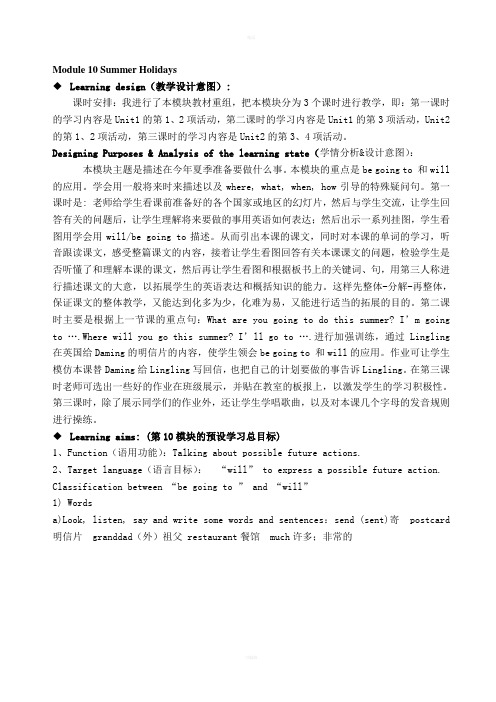
Module 10 Summer Holidays◆Learning design(教学设计意图):课时安排:我进行了本模块教材重组,把本模块分为3个课时进行教学,即:第一课时的学习内容是Unit1的第1、2项活动,第二课时的学习内容是Unit1的第3项活动,Unit2的第1、2项活动,第三课时的学习内容是Unit2的第3、4项活动。
Designing Purposes & Analysis of the learning state(学情分析&设计意图):本模块主题是描述在今年夏季准备要做什么事。
本模块的重点是be going to 和will 的应用。
学会用一般将来时来描述以及where, what, when, how引导的特殊疑问句。
第一课时是: 老师给学生看课前准备好的各个国家或地区的幻灯片,然后与学生交流,让学生回答有关的问题后,让学生理解将来要做的事用英语如何表达;然后出示一系列挂图,学生看图用学会用will/be going to描述。
从而引出本课的课文,同时对本课的单词的学习,听音跟读课文,感受整篇课文的内容,接着让学生看图回答有关本课课文的问题,检验学生是否听懂了和理解本课的课文,然后再让学生看图和根据板书上的关键词、句,用第三人称进行描述课文的大意,以拓展学生的英语表达和概括知识的能力。
这样先整体-分解-再整体,保证课文的整体教学,又能达到化多为少,化难为易,又能进行适当的拓展的目的。
第二课时主要是根据上一节课的重点句:What are you going to do this summer? I’m going to ….Where will you go this summer? I’ll go to ….进行加强训练,通过Lingling 在英国给Daming的明信片的内容,使学生领会be going to 和will的应用。
作业可让学生模仿本课替Daming给Lingling写回信,也把自己的计划要做的事告诉Lingling。
人教新目标英语八上u10教案

人教新目标英语八上u10教案Title: Teaching Plan for New Target English Grade 8 Unit 10Unit 10: The Olympic GamesTeaching Objectives:1. Students will be able to understand and use vocabulary related to the Olympic Games, such as sports, athletes, and events.2. Students will be able to discuss the history and significance of the Olympic Games.3. Students will be able to write a short paragraph about their favorite Olympic sport.Teaching Content:1. Vocabulary: sports, athletes, events, medals, podium, torch, host city, opening ceremony, closing ceremony, etc.2. Grammar: present simple tense, past simple tense, comparative and superlative forms of adjectives.3. Reading: a passage about the history of the Olympic Games.4. Writing: a short paragraph about students' favorite Olympic sport.Teaching Procedures:Step 1: Warm-up (10 minutes)- Greet the students and ask them if they have ever watched the Olympic Games on TV or in person.- Show pictures of different Olympic sports and ask students to name them.- Introduce the topic of the lesson: The Olympic Games.Step 2: Vocabulary (20 minutes)- Introduce new vocabulary related to the Olympic Games, such as sports, athletes, events, medals, podium, torch, host city, opening ceremony, closing ceremony, etc.- Use flashcards, pictures, and realia to help students understand and remember the new words.- Practice pronunciation and spelling of the new vocabulary.Step 3: Reading (20 minutes)- Read a passage about the history of the Olympic Games as a class.- Ask students comprehension questions to check their understanding of the passage.- Discuss the significance of the Olympic Games in promoting peace and understanding among nations.Step 4: Grammar (20 minutes)- Review the present simple tense, past simple tense, and comparative and superlative forms of adjectives.- Give examples of how these grammar points are used in the context of the Olympic Games.- Have students practice using these grammar points in sentences related to the Olympic Games.Step 5: Writing (20 minutes)- Ask students to think about their favorite Olympic sport.- Have students write a short paragraph about why they like that sport and what makes it special.- Encourage students to use the vocabulary and grammar they have learned in the lesson.Step 6: Group Activity (20 minutes)- Divide the class into small groups and assign each group a different Olympic sport.- Have each group discuss the history, rules, and significance of their assigned sport.- Each group will then present their findings to the class.Step 7: Conclusion (10 minutes)- Review the new vocabulary and grammar points covered in the lesson.- Summarize the history and significance of the Olympic Games.- Assign homework: Write a short essay about the impact of the Olympic Games on the world.Teaching Materials:- Textbook: New Target English Grade 8- Flashcards, pictures, and realia related to the Olympic Games- Reading passage about the history of the Olympic Games- Writing prompts for students' favorite Olympic sportTeaching Assessment:- Participation in class discussions and activities- Completion of vocabulary and grammar exercises- Quality of writing in the short paragraph aboutstudents' favorite Olympic sportOverall, this teaching plan for New Target English Grade 8 Unit 10 aims to engage students in learning about the Olympic Games through vocabulary, grammar, reading, writing, and group activities. The goal is for students to gain a better understanding of the history and significance of the Olympic Games while improving their English language skills.。
《英语》(新标准)(一年级起点)第八册教学设计M10
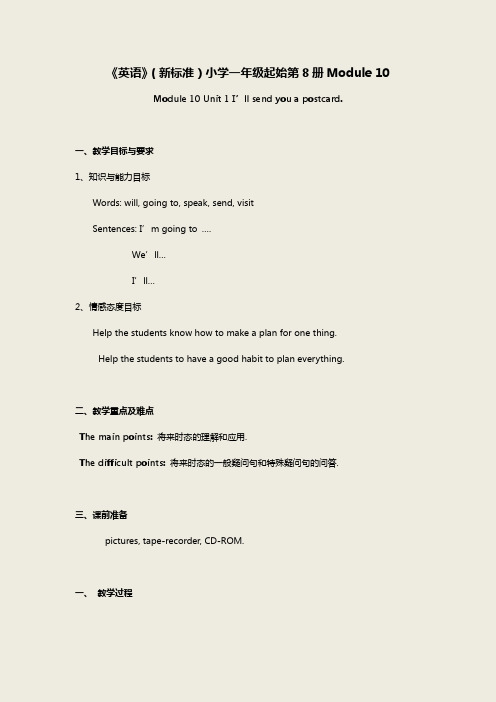
《英语》(新标准)小学一年级起始第8册Module 10 Module 10 Unit 1 I’ll send you a postcard.一、教学目标与要求1、知识与能力目标Words: will, going to, speak, send, visitSentences: I’m going to ….We’ll…I’ll…2、情感态度目标Help the students know how to make a plan for one thing.Help the students to have a good habit to plan everything.二、教学重点及难点The main points:将来时态的理解和应用.The difficult points:将来时态的一般疑问句和特殊疑问句的问答.三、课前准备pictures, tape-recorder, CD-ROM.一、教学过程Step 1 Warm upa)Game: listen, do and repeat: play football, play basketball, sing …b)Free talk: What did you do yesterday?What will you do tomorrow? I’ll …Step 2 Presentation and practice1.Learn “going to”:T: What will you do this summer?S: I will …T: I will go to Beijing this summer. I am going to go to Beijing this summer.( B.B: will = going to )S: I’m going to …( Help the Ss to answer the questions and talk about their plans use “going to”. )2.Practice of “going to”:T: I’m going to speak English this summer. What are you going to do this summer?S: I’m going to …Play a game: ask and answer one by one.S1: I’m going to …What are you going to do?S2: I’m going to …What …?3.Learn “send postcard”:This summer I am going to go to Beijing. Beijing is beautiful, I’ll send you apostcard from Beijing.( Teach: send, postcard )( Make a sentence: I’ll send you a postcard from _____ . )4.Presentation of the dialogue:1)Listen and answer the questions:Where is Amy going to go this summer?What is Amy going to do this summer?What will Daming do?Will they send a postcard to Daming?2) Listen, point and find “will, going to”.1)Read the sentences “I’m going to …”“I’ll …”2)Read the dialogue.Step 3 Consolidation and extension1. Act the dialogue.2. Finish an exercise:This summer, Amy is going to go back to ______. ______ is going to go, too.Lingling is ______ to speak _____ everyday. Maybe Damiong ______ visit his grandpa’s _______. He will _____ a postcard from China. Amy and Lingling will send a ______ from England.3. Make a survey:Name ging toDaming vsit a farmStep 4 SummaryDo you know to say your plan? Do you remember the children’s plan? Step 5 Homework1.Listen to the tape and read after it for 5 times.2.Try to act the dialogue with your friends3.Talk about your summer vocation plan.Step 6 Blackboard designModule 10 Unit 1I’ll send you a postcard.I’m going to …I’ll send you a postcard from…Module 10 Unit 2 I’m going to go to London.一、教学目标与要求1、知识与能力目标了解一般将来时态的结构,会运用一般将时态进行描述。
《英语》(新标准)(初中阶段)初二上册M10U1教学设计2

学情分析
初二上课期的学生经过一年多的学习,有了一定的英语基础知识和说的能力,同时,经过一年的新课程理念的陶冶及实践,有了初步的自立、合作、探究、实验的能力。此外学生随着年龄的增长开始羞于表达,因此在课堂上如何调动学生说的兴趣并进一步培养他们与他人合作探究的能力是我们必须关注的问题。
模块教学目标
知识目标:学习掌握描述天气的表达方法;学习may, might, must, properly等词的用法。
Ask the students to practice with their deskmates, so we can get a general idea of may/ might/ probably.
Audio-visual teaching method
Task-based teaching method
教学内容
教学活动
设计意图
教师活动
学生活动
Step 1:
StepILead-in
The first step is warm-up. First, the students should check their new words in groups. Then we will have a free talk. We can use some information of the daily report. Such as: What’s the weather like today? Is it cold? What’s the temperature today? Then we will talk about the weather of tomorrow. So we can practice the general future tense, which can prepare for the listening practice. Here the students should pay attention to the role of changing the nouns into adjectives
《英语》(新标准)(初中阶段)初二下册M10U1教学设计1

学生经过一年多的英语学习,八年级学生具备了一定相应的英语语言知识,能够用英语表达常见的简单情景,学到了相关的基础知识,但是整体而言八年级学生的基础知识不够扎实,词汇量有限,英语思维有待提高;上课的是初二·11班学生,这个班学生整体而言英语学习层次不齐,部分同学在英语学习中存在困难。
但是通过第九模块上一个单元的学习,学生们已经初步了解宾语从句的使用,并且逐渐认识到了梦想的重要性,为本单元的学习做了充分准备。
1.语言知识目标:。
M10教案

Module 10 Unit 1 Did you fall off your bike?主备人:苏兴慧一、、教学目标1.认知目标:本课难点:培养学生在具体生活情景中用英语表情达意的综合语言运用能力本课重点:培养学生在原有知识基础上总结出动词过去式规则及不规则的表示方法。
2. 本课教学准备:单词卡、磁带、PPT制作3.技能目标:1)培养学生在一定语言知识基础上,总结归纳语法要点的能力,授之以渔。
2)看图编故事或讲述、表演课文情景或平时发生在自己身边的小意外(事故),发挥想像力,增强语言综合运用能力。
4.评价目标:形成性评价与终结性评价相结合,使教师及时调整方法策略,更好地完成教学任务。
课前预测:二、教学过程与评析一)组织教学(Organization of class )1.问候:Hello. Boys and girls. How are you?I'm happy! Are you happy?2学生分组,并选出组长。
Excellent, Thank you. This time I'll divide you into four groups, Please choose your leaders.(组长根据组员在课堂上的表现给予口头评价,并记录在课前为之准备的评价表上。
)【设计目的】把学生分成4个小组,每小组再划分好合作小组围成U”字型来坐,利于培养学生的参与意识、合作精神,同时引进竞争机制,激发学习意志。
二)导课( Presentation )T:Do you remember “过去式”?Do you like chant?点击课件,出现chant::" Boys Girls Clap clap Clap clap our hands We are todayWe are yesterdayToday today today Yesterday yesterdayPhone phone phone Phoned phoned phonedPlay play play Played played playedRain rain rain Rained rained rainedCarry carry carry Carried carried carried【设计目的】以chant的形式复习已学过的动词过去式,并以此导出新单词carried ,以便温故知新。
《英语》(新标准)(初中)八年级上册M10第二课时教学设计2
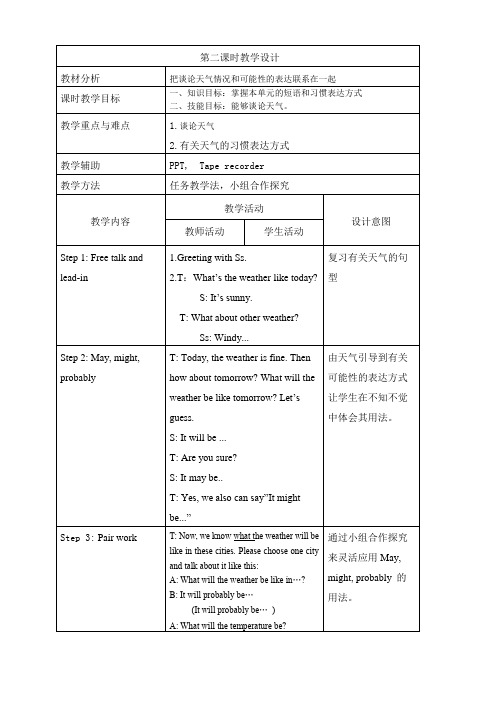
Step 5:Discussion
1. T: Discuss what will the weather be like the model:
A: What will the weather be like in ..., tomorrow ?
B: I think it might/may be...
2. Check the ture sentences in activity4
3. Fill the blanks snow.…
It may be...
It might be...
It will probably be…
第二课时教学设计
教材分析
把谈论天气情况和可能性的表达联系在一起
课时教学目标
一、知识目标:掌握本单元的短语和习惯表达方式
二、技能目标:能够谈论天气。
教学重点与难点
1.谈论天气
2.有关天气的习惯表达方式
教学辅助
PPT, Tape recorder
教学方法
任务教学法,小组合作探究
教学内容
教学活动
设计意图
教师活动
A: Do you like the weather in…?
B: Yes, I do./ No, I don’t. And you?
A: Me, too./ Me, neither.
通过小组合作探究来灵活应用May, might, probably的用法。
Step 4:Group work
T: Today,I listened to the weather about China, I learned the weather of today in these cities. But I didn’t finish listening, so I don’t what weather these cities will be.
【人教版】新目标八年级英语上册:Unit10单元说课稿

【人教版】新目标八年级英语上册:Unit 10 单元说课稿一. 教材分析人教版新目标八年级英语上册Unit 10主要讲述了关于旅行的话题。
通过本单元的学习,学生能够掌握一般过去时的被动语态,了解不同国家的风土人情,提高自己的跨文化交流能力。
教材内容丰富,包括听力、口语、阅读和写作等方面,旨在全面提升学生的英语综合运用能力。
二. 学情分析八年级的学生已经具备了一定的英语基础,对于一般过去时和被动语态有一定的了解。
但部分学生可能在实际运用中仍有困难,需要加强练习。
此外,学生对于不同国家的文化了解还不够深入,需要通过本单元的学习进行拓展。
三. 说教学目标1.知识目标:(1)掌握一般过去时的被动语态结构及用法;(2)了解世界各国的主要风土人情;(3)提高跨文化交流能力。
2.能力目标:(1)能熟练运用一般过去时的被动语态进行口头和书面表达;(2)提高听力理解能力,能听懂关于旅行的话题;(3)提高阅读理解能力,能读懂关于不同国家文化的文章。
3.情感目标:培养学生对不同文化的尊重和理解,提高他们的跨文化意识。
四. 说教学重难点1.教学重点:(1)一般过去时的被动语态结构及用法;(2)世界各国的主要风土人情;(3)跨文化交流能力的培养。
2.教学难点:(1)一般过去时的被动语态在实际情景中的运用;(2)对不同国家文化背景的理解和掌握。
五. 说教学方法与手段1.教学方法:(1)情境教学法:通过设置各种旅行情境,让学生在实际语境中学习和运用语言;(2)交际法:鼓励学生积极参与课堂交流,提高他们的口语表达能力;(3)任务型教学法:通过完成各种任务,让学生在实践中掌握语言知识。
2.教学手段:(1)多媒体教学:利用图片、音频、视频等丰富的教学资源,提高学生的学习兴趣;(2)网络资源:利用网络平台,让学生了解更多的旅行相关信息;(3)小组合作:鼓励学生进行小组讨论和合作,提高他们的团队协作能力。
六. 说教学过程通过展示一组旅行图片,引导学生谈论自己最喜欢的旅行目的地,从而引出本课主题。
八上M10教案
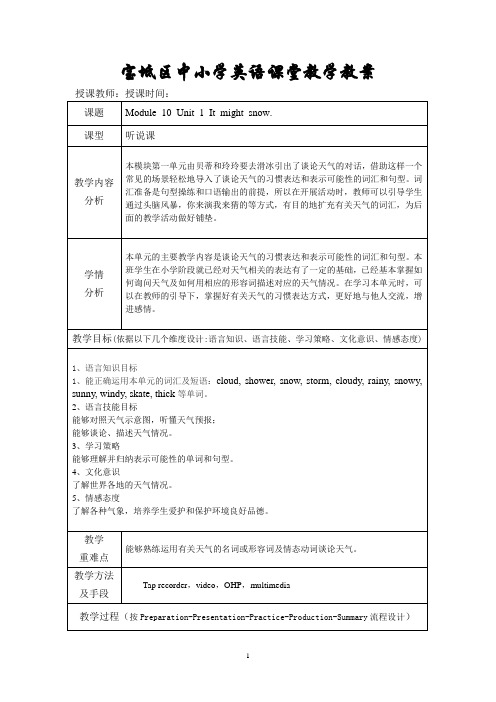
5分
22分
10分
5分
作业布置
Complete the sentences with the words in the box(Activity4).
板书设计
Module 10 The weather
Unit1.It might snow.
1.Are you joking? 2. Sounds great!
3. Me neither. e on, better get going!
5. What’s the temperature? 6. It’s probably sunny and hot there.
7.Rainy weather is terrible!
8.I like sunny weather ,and I like snow as well.
3.Read and remember
Ask students to read the dialogue in groups and try to find out some important language points by themselves then help them solve the difficult points if necessary.
1. Listen and answer:
Have the students listen to the tape and complete the sentence:
①What’s theand minus_____degrees!
3、学习策略
掌握谈论天气情况的习惯表达方式。
4、文化意识
了解世界各地的天气情况。
5、情感态度
培养学习地理知识的愿望和兴趣。
《英语》(新标准)(初中)八年级上册M10U1 教学设计 (2)
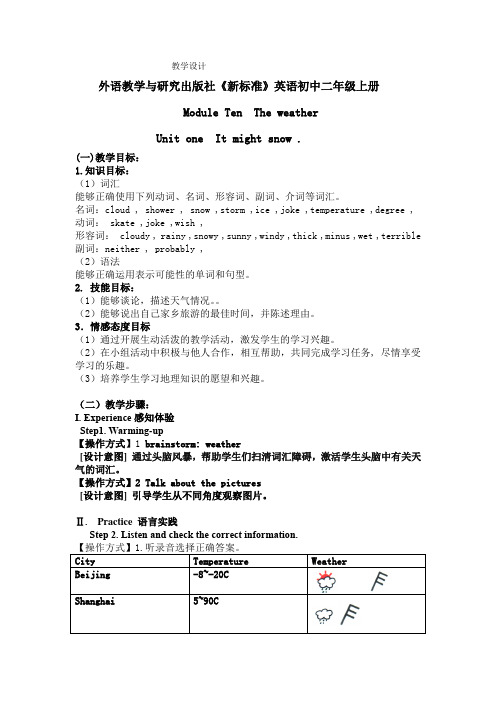
教学设计外语教学与研究出版社《新标准》英语初中二年级上册Module Ten The weatherUnit one It might snow .(一)教学目标:1.知识目标:(1)词汇能够正确使用下列动词、名词、形容词、副词、介词等词汇。
名词:cloud , shower , snow ,storm ,ice ,joke ,temperature ,degree , 动词: skate ,joke ,wish ,形容词: cloudy , rainy ,snowy ,sunny ,windy ,thick ,minus ,wet ,terrible 副词:neither , probably ,(2)语法能够正确运用表示可能性的单词和句型。
2. 技能目标:(1)能够谈论,描述天气情况。
(2)能够说出自己家乡旅游的最佳时间,并陈述理由。
3.情感态度目标(1)通过开展生动活泼的教学活动,激发学生的学习兴趣。
(2)在小组活动中积极与他人合作,相互帮助,共同完成学习任务, 尽情享受学习的乐趣。
(3)培养学生学习地理知识的愿望和兴趣。
(二)教学步骤:I. Experience感知体验Step1. Warming-up【操作方式】1 brainstorm: weather[设计意图]通过头脑风暴,帮助学生们扫清词汇障碍,激活学生头脑中有关天气的词汇。
【操作方式】2 Talk about the pictures[设计意图] 引导学生从不同角度观察图片。
Ⅱ.Practice 语言实践Step 2. Listen and check the correct information.【操作方式】1.听录音选择正确答案。
City Temperature WeatherBeijing -8~-20CShanghai 5~90CXi’an-5~10CGuangzhou 10~210CHong Kong 17~200C[设计意图]引导学生熟悉天气预报中的气象符号及温度的表达方式。
《英语》(新标准)(初中阶段)初二上册M10U1教学设计1
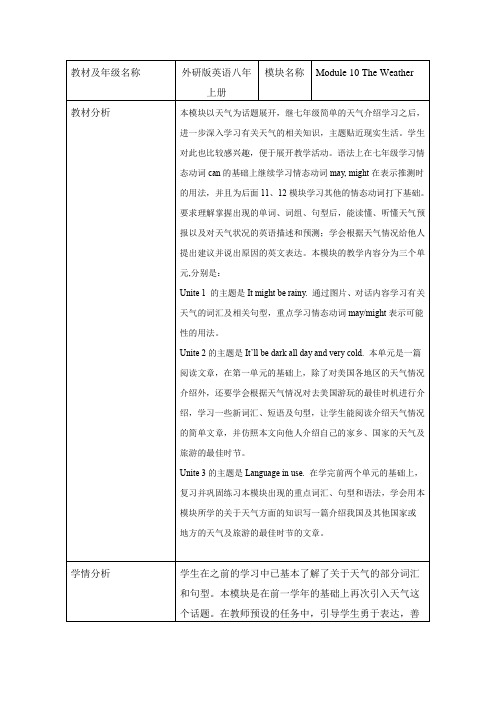
Unite 2的主题是It’ll be dark all day and very cold.本单元是一篇阅读文章,在第一单元的基础上,除了对美国各地区的天气情况介绍外,还要学会根据天气情况对去美国游玩的最佳时机进行介绍,学习一些新词汇、短语及句型,让学生能阅读介绍天气情况的简单文章,并仿照本文向他人介绍自己的家乡、国家的天气及旅游的最佳时节。
难点
1.掌握表达天气的词汇和句型,并能熟练准确地加以运用。
2.准确运用情态动词may, might/propbably表示可能的结构。
教学辅助
图片,课件,一体机
教学方法
借助图片使学生学习天气、气候的相关词汇,并以提问、启发的方式教学对话部分的能容,重点是可能的表达,通过小组对话、听录音练习掌握天气的表达法。
情感目标
1.通过学习打招呼、谈论天气等日常交际用语,增进彼此的情感、学会与人友好相处。
2.了解不同国家、地区不同的天气情况,互相交流各自的文化风情,对学生进行不同文化知识的渗透。
教学重点与难点
重点
1.掌握介绍天气的词汇及句型,并运用所学的知识与他人进行有关天气话题的讨论。
2.掌握情态动词may/might表示可能性的用法。
教学辅助
图片,课件,一体机
教学方法
本模块的主题是有关天气的内容,教师用图片、天气标示来帮助学生理解记忆有关天气、气候的词汇,通过对话练习训练学生的实际运用能力,并提醒学生在平时的生活中善于关注天气,还要学会根据天气情况对自己的家乡、国家及其他国家旅游的最佳时节进行介绍,同时学会用所学的英语知识去思考天气、气候的表达法。
- 1、下载文档前请自行甄别文档内容的完整性,平台不提供额外的编辑、内容补充、找答案等附加服务。
- 2、"仅部分预览"的文档,不可在线预览部分如存在完整性等问题,可反馈申请退款(可完整预览的文档不适用该条件!)。
- 3、如文档侵犯您的权益,请联系客服反馈,我们会尽快为您处理(人工客服工作时间:9:00-18:30)。
新标准英语第八册M10教案《英语》(新标准)(供三年级起始用)第八册Module10第一课时(40分钟)教学内容:SB(学生用书)与AB(课堂活动用书)Unit 1We are going to speak Chinese.教学目标:1、学习语句:We are going to speck Chinese.Are you going to go to middle school this September?Yes. I’m really excited.2.能口头运用Are you going to go to middle school this September?询问对即将到来的中学生活的判断是否准确。
3、识别单词:middle school, study, practice, worry书写单词:school重难点:1、能口头运用Are you going to go to middle school this September?询问对即将到来的中学生活的判断是否准确。
2、识别单词:middle school, study, practice, worry书写单词:school功能:用一般将来时描述自己的计划和将要发生的事情。
教学程序:一、热身复习1、教师与学生热情问候。
然后与学生谈论他们这个周末的计划。
例如:A: What are you going to do ?B: I am going to …二.任务呈现与课文导入1、教师可以和学生谈论一下他们在中学所要学习的科目。
并把相关单词进行板书,然后请学生通过朗读来复习这些有关学科名称的单词。
2、教师告诉学生:“Sam, Daming和Amy也即将进入中学,我们现在来听听他们所讨论的中学生活。
”三、课文教学1、呈现第一单元活动1。
先请学生听录音,并勾出课文中的生词。
2、先鼓励学生根据上下文猜测新单词的意思,教师再进行教授。
要求学生跟读,然后在请个别学生进行朗读,以便纠正学生的发音。
重点要求学生能识别,理解单词middle school, study, practice, worry,并能书写单词school。
3、再次播放录音,要求学生边听边在书上划出带有“going to ”的句子,帮助学生回顾“be going to”的结构表示将要发生的动作。
然后针对课文中的难点进行讲解,也可以让学生就自己理解有困难的地方进行提问。
当然也可以请程度较好的学生进行讲解。
4、重点练习“be going to”的用法。
请学生使用这个句型结构来造句。
5、播放课文录音,逐句停顿,请学生跟读。
6、请学生两人一组,完成SB第一单元活动2的练习。
学生可以先听录音再进行模仿朗读。
四、任务完成1、完成SB第一单元活动3。
先请学生看活动3中的范例,然后教师请学生来谈谈他们这个暑假的计划或者询问别人的暑假计划。
教师注意进行及时鼓励和指导。
2、请学生回忆自己的类似经历,然后用同样的句式来表达。
五、课后作业1、完成AB第一单元练习1和2。
请学生根据答案来选择问题。
2、完成AB第一单元练习2。
3、完成AB第一单元练习3。
请学生根据自己的实际情况来回答问题。
第二课时(40分钟)学习内容:SB(学生用书)与AB(课堂活动用书)Unit2 What are you going to study?教学目标:1、学习语句:What are you going to study? I’m going to study Science.2、能听懂并能口头运用I’m going to study Science.介绍将来的中学生活。
3、识别单词:history, geography, physics, chemistry书写单词:middle重难点:1、能听懂并能口头运用I’m going to study Science.介绍将来的中学生活。
2、识别单词:history, geography, physics, chemistry书写单词:middle功能:继续谈论即将开始的中学生活。
教学程序:一、热身复习请学生说说有关科目名称单词,并请学生把单词板书在黑板上。
特别强调history, geography, physics, chemistry四门学科,要求学生能识别。
二、任务呈现与课文导入教师告诉学生:“今天我们要来做一个英文课程表。
在制作之前,我先来了解一下中学将要学习的科目。
”三、课文教学1、请学生看SB第二单元活动1中的图,请学生读出图中科目名称。
2、播放录音,让学生听听图中男孩然和女孩即将在中学学习的科目。
再播放录音。
要求学生仔细听,并复述录音内容。
3、完成SB第二单元活动2。
请学生根据范例,用第三人称来说说两个孩子即将在中学学习的科目。
4、完成SB第二单元活动3。
教师告诉学生圈出自己喜欢的三门学科,然后和同学进行对话。
通过询问来了解对放想要学习的科目,然后进行转述。
教师可以先知道学生阅读范例对话,然后进行示范,在要求学生进行练习。
四、任务完成1、完成SB第二单元活动5。
先请学生看活动5中的范例对话,再选几个程度较好的学生做一个示范,然后在请学生以开火车的形式开展活动。
教师进行及时地评价。
2、完成制作英文课程表的活动。
鼓励学生制作出具有特色的课程表。
五、课文学习播放SB第二单元活动4诗歌的录音。
引导学生根据插图来理解韵诗的大意。
再次播放录音,请学生边听边跟读,也可以请学生进行现场表演。
然后鼓励学生集体朗诵。
六、课后作业1、请学生完成AB第二单元练习1和2。
2、AB第二单元练习4可以根据学生程度进行选择完成。
Review Module第一课时(40分钟)教学内容:SB(学生用书)与AB(课堂活动用书)Unit 1教学目标:1、运用并掌握常见的动词过去式词汇,如:went, saw, did, ate, was, sent等。
其他过去式词汇不作要求,学生根据自己的情况记忆与掌握。
2、系统复习与运用一般过去时的句子。
3、复习在快餐店点餐。
功能:复习本册书中学过的全部内容,通过完成各个活动对本学期学过的知识进行巩固和综合运用。
重难点:1、运用并掌握常见的动词过去式词汇。
2、系统复习与运用一般过去时的句子。
教学程序:一、热身复习教师与学生热情问候.复习本册书所学过的诗歌和歌曲,形式可以多样化,例如:可以以小组为单位,进行诗歌、歌曲大比拼。
二、课文教学1、完成SB第一单元活动1。
请学生先阅读表格中的内容,在表格的提示下回忆本册书中所学习的人物和发生的事件。
仔细思考表中的三栏内容应该怎样搭配。
如果学生独立完成有一定的困难。
可以采取小组讨论的形式进行。
然后请部分学生说说自己的答案,最后全班集体订正。
2、完成SB第二单元活动2。
活动可以以“接龙”的形式进行,由每组轮流派一名代表参与活动。
例如:A: Yang Liwei…B:...went in a spaceship…C:…and made a video.教师注意现场指导。
3、完成AB第二单元活动1. 教师可以请学生先读出这些动词的过去式,然后再进行选词填空的练习。
4、完成SB第二单元活动3。
请学生先看活动3中的图片,然后根据图片所呈现的内容试着配上相应的语言。
然后再播放录音,请学生边听边重复,再与自己刚才的答案进行对比和订正。
鼓励学生提出问题,教师给予指导。
最后完成AB第二单元活动3。
三、课后作业1、完成SB第一单元活动4。
鼓励学生以小组为单位进行编剧和表演。
第二课时(40分钟)学习内容:SB(学生用书)与AB(课堂活动用书)Unit2教学目标:1、复习现在进行时,谈论正在做一件事情时,另一件事情同时发生。
2、复习一般将来时,谈论计划或打算,询问原因及回答。
3、写一写自己经历过的一件难忘的事情。
重难点:1、复习现在进行时,谈论正在做一件事情时,另一件事情同时发生。
2、复习一般将来时,谈论计划或打算,询问原因及回答。
3、写一写自己经历过的一件难忘的事情。
教学程序:一.热身复习请学生以小组为单位进行,表演SB第一单元活动4中的短剧。
然后请学生进行互评,教师进行点拨,然后评选出“最佳表演组合”。
二、课文教学1、请学生看SB第二单元活动1中的图,请学生试着来描述图中的情景,看一看,说一说图中的情景是否合理,为什么。
然后请学生读读活动1中的例句,鼓励学生针对每一幅图,按照例句的形式进行描述。
如果学生独立完成有困难,可以让他们进行组内讨论。
2、完成SB第二单元活动2。
先请学生自己阅读范例对话,然后请个别学生来说说应该怎样进行游戏。
然后教师将学生分为三人一组,一位同学先出示表示天气的标志性图片,然后其余两位同学按照范例对话开展游戏。
三个学生之间可以轮换角色。
当然教师应鼓励学生问出更多的问题,做一个适当的拓展。
3、完成SB第二单元活动3。
教师先告诉学生:“这是Smart一家在假期中一天的活动时间安排。
”然后请学生观察活动3中的图片,来说说他们一家人在这一天内的活动计划。
例如:They are going to have breakfast at 8. 然后播放录音,请学生自己听。
再次播放录音,请学生重复每句话,学生可以就自己不理解的地方进行提问。
然后完成SB第二单元活动4。
提示学生参考活动4中的范例对话进行练习。
4、完成AB第二单元活动3。
请学生先来阅读练习3中的表格内容,然后请学生自己选择自己计划要做的活动项目和时间,并填写表格。
完成表格后,根据自己所填的内容,完成AB第二单元活动4。
教师可以先请学生来说说自己的计划。
5、完成SB第二单元活动5。
先请学生来看看活动5中的照片,然后请学生来描述这些照片,最后学生两个人一组,按照书上的范例对话进行练习。
6、完成AB第二单元活动5。
请学生先看图,然后全班集体回忆这些谜语,并用针对谜语尽心个问答。
例如:Why was 6 afraid of 7? Because 7,8,9.7、完成AB第二单元活动2。
请学生根据所提供的图片,比较两幅图的区别,然后参考例句进行描述。
四、课后作业1、完成AB第二单元练习1。
放手让学生进行阅读,教师可以针对学生的问题进行个别辅导。
